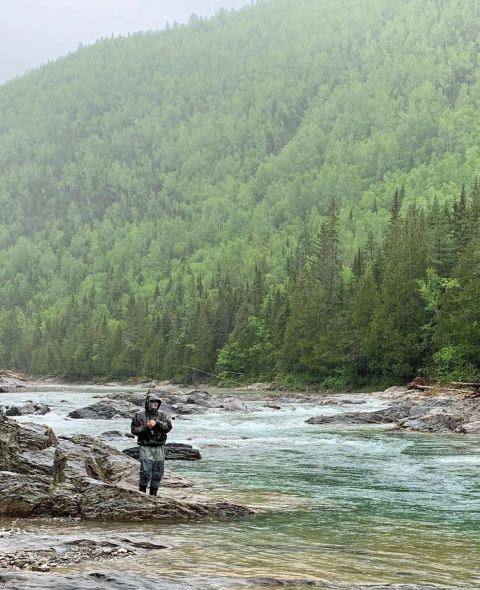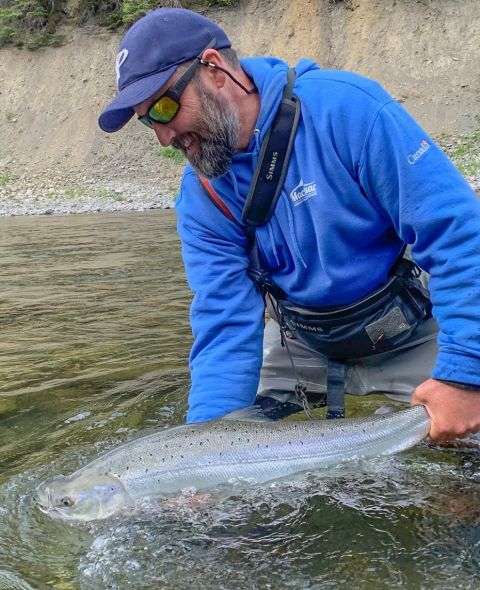
Subscribe & stay up-to-date with ASF


Phone cameras, GoPros, and other small waterproof cameras are now extremely good. Sharp, fast and excellent focus, and able to grab the moment of live release with incredible quality. Use them to bring back digital treasures you can have on your computer screens, framed on your walls, or shared with friends on phones and facebook.
But a couple of special notes need to addressed.
First, do not hold the fish out of the water, especially not at waist height. Salmon work hard to battle you, and need to be given every opportunity to recover after the fight. Keeping them in the water makes a big difference. Do your best to not lift their mouths and gills into the air—even a few seconds puts undue stress on the fish.
Second is a point of anatomy and physiology of Atlantic salmon. Their heart is located far forward, not too far behind the gills. If you lift them in the foreward area, such as in the case below, it squeezes the area around the heart, making it even harder for the salmon to recover, and even doing long term damage to your wonderful fish. Support the salmon in the water, most especially in that area.
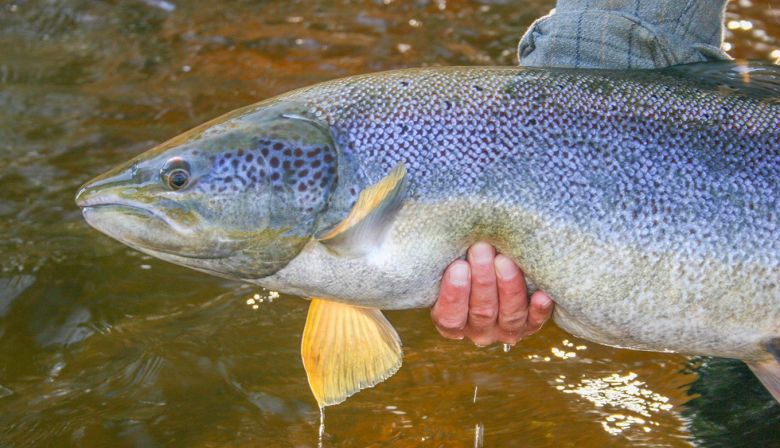
Practised correctly, live release causes almost no mortality. Peer-reviewed research has shown that properly released Atlantic salmon are successful in spawning, and may well survive as kelts to repeat their migration to sea and subsequent returns.
Do the best you can, while taking home gorgeous digital trophies that can be shared for years to come.
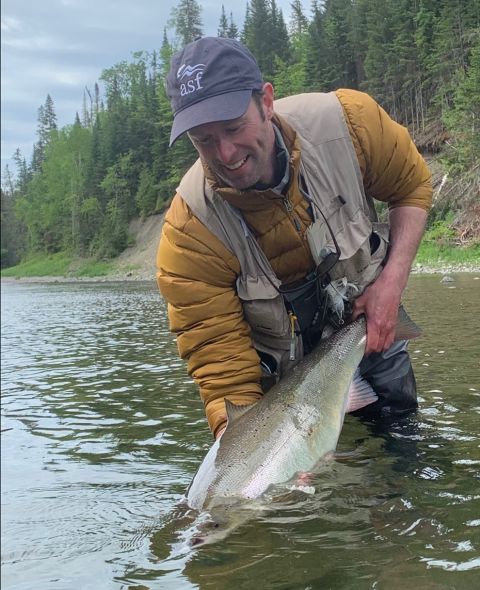
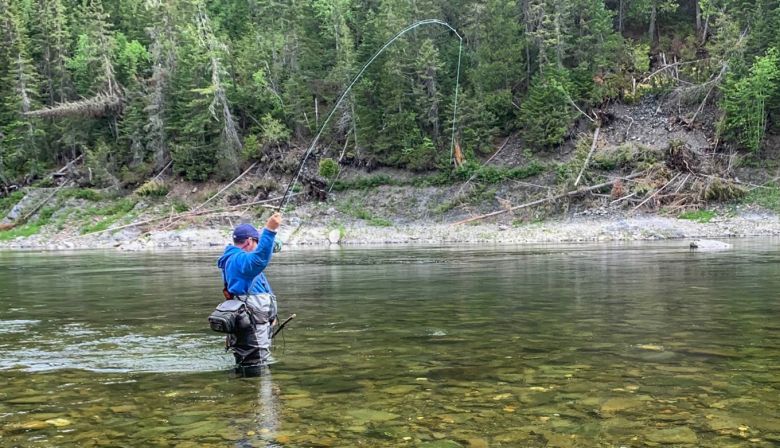
Restigouche
Nathan Wilbur, ASF Director of Regional Programs, has been in the Restigouche River system this week. He notes that while water levels are very low for this time of year, the temperatures continue to be cool to cold.
He also notes that Atlantic salmon are coming into the river, although not in great numbers at this time.
Danny Bird of Kedgwick Lodge says:
Water came up a wee bit this week. However, we are not seeing great numbers of fish thus far. Water temperature rose a bit as well.
Miramichi
The Northwest Miramichi Barrier as of June 13 had counted 15 large salmon and 5 grilse.
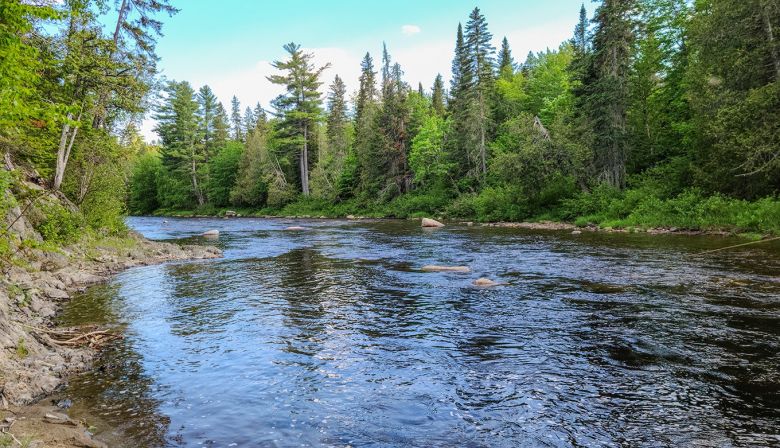
Paul Elson Jr. says:
A few Atlantic salmon are on the move, but there has been no big run yet.
Water is extremely low for this time of year and we need a good rain.
Brock Curtis in Blackville notes:
I just had a report from a friend in the Upper Blackville area who lost a salmon, then landed one and lost two grilse.
This happened today. We had rain here and the river is raising. There seems to be a good run of salmon right now, according to my sources.
From what I am seeing and hearing we have salmon moving here in the Blackville area and we expect good fishing for the next couple of days. Certainly today (Thursday) Atlantic salmon are being found both above and below Blackville. Quite encouraging.
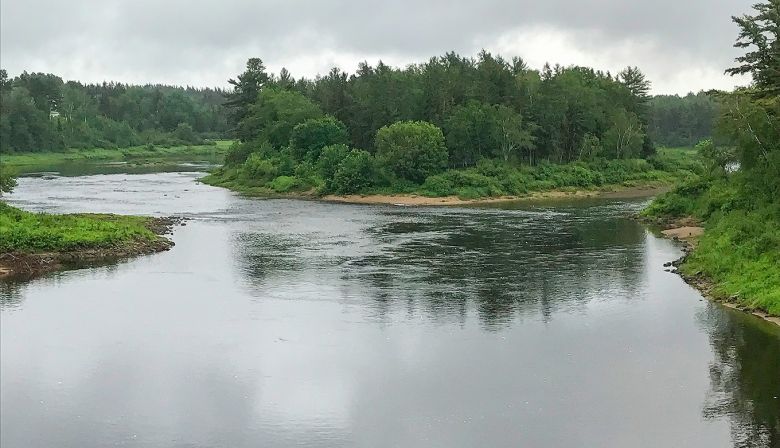
The Dungarvon Counting Fence posted just 2 large salmon as of 13 June 2021. But certainly, just early days.
Trap net data has only been posted to June 1. It had 10 large salmon and 1 grilse for the Northwest Cassilis Trap, and for the Millerton Trap on the Southwest Miramichi, 4 large salmon and no grilse.
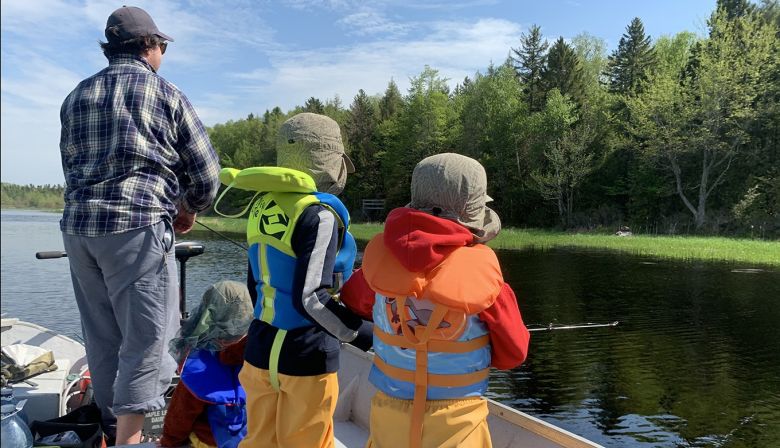
Neville Crabbe was recently on Spednic Lake, on the St. Croix River system:
Spednic Lake is part of the St. Croix watershed that separates Maine and New Brunswick starting at North Lake and East Grand Lake and stretching to Passamaquoddy Bay. The St. Croix International Waterway Commission has a mandate to connect people with this wilderness area and they manage a network of campgrounds and backcountry sites. Over the Victoria Day weekend my wife and I took our three boys camping at Spednic Lake Provincial Park, now managed by the waterway commission.
Henry (6), Theodore (5), and August (2) are serious about the outdoors, and getting away is an important part of family summers. We boated around and fished as time and temperament allowed, including up the Diggity stream which connects Spednic to Wauklahegan Lake and beyond. At the mouth of the stream there’s a wilderness campsite with a plaque marking thousands of years of use by Indigenous people.
Excavations there in the 1980s recovered evidence of two millennia of continuous use, an incredible reminder that history is all around us. The water there is spotted with large boulders and soft weedy edges. Using a spinner my five year old, Theodore, hooked a decent size fall fish, what some people call chub. It was almost to the boat when a shape started rising like a submarine. You could sense before seeing the outline of a large fish was visible in the deep water. Suddenly the fall fish thrashed frantically on the hook: it was ripped free and gulped down by the larger animal.
We all exploded with a collective, “What!” Thinking later, I’m sure it was a very large largemouth bass. Smallmouth were introduced in the St. Croix in the 1800s, but largemouth are relative newcomers, surely introduced by anglers to start a fishery – part of a pattern of ecological manipulation in the St. Croix watershed and something much different that the First People at the Diggity site would have encountered.
The St. Croix is now the focus, and has been for some time, of a major Indigenous, government, NGO effort to restore passage upstream for native species blocked by the collection of dams between Spednic Lake and tidewater. Unfortunately there’s a new predator waiting.
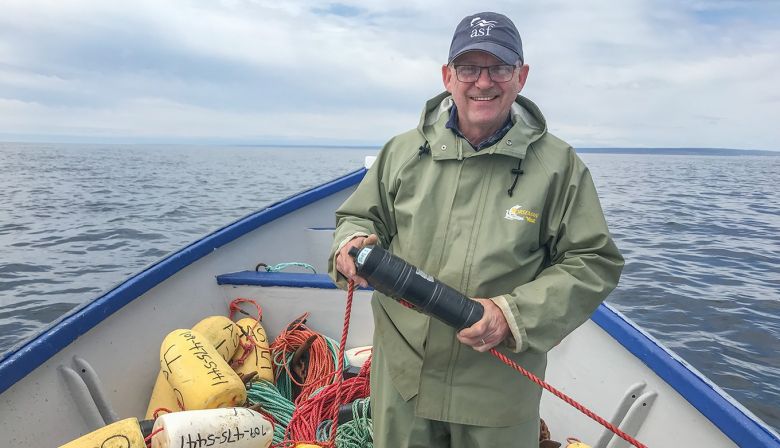
This year, he was able to say that the deployment of equipment went well.
Loomis, the Captain, had arranged gear on the dock and that made the effort go more efficiently. Also, he had a larger boat in 2021, and that let us do the deployment of the two array lines of receivers in three trips instead of four, as previously.
The situation seemed different on the water this year. There were a lot of capelin around. And it was extraordinary, but we observed more than 100 humpback whales feeding. I have never seen anything like it.
On the other hand there were relatively few seabirds to be seen, such as gannets.
The equipment itself was more easily deployed this year, since sea conditions were better.
Along his drive north Don Ivany took a series of photos of the Atlantic salmon rivers. As noted previously, generally water levels are low, due to the reduced snow pack this winter, and moderate rain since in western Newfoundland.
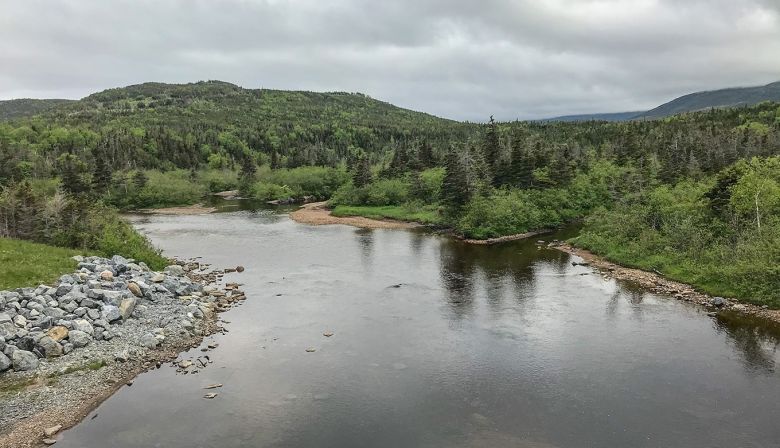
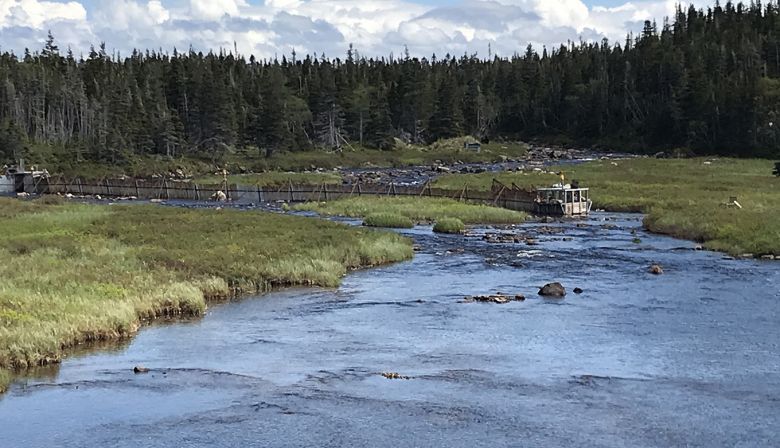
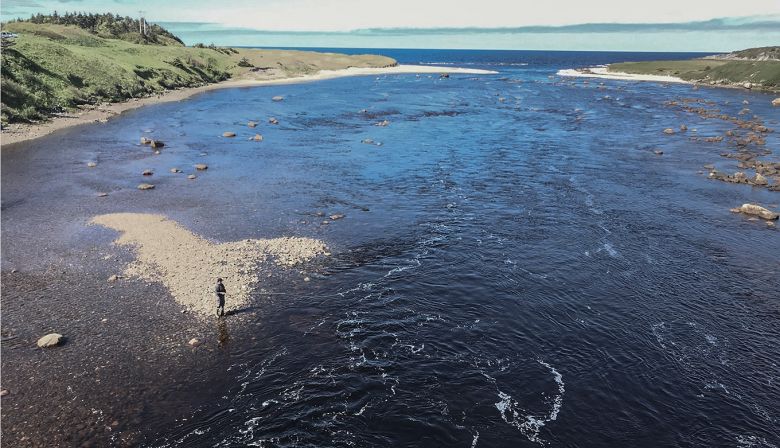
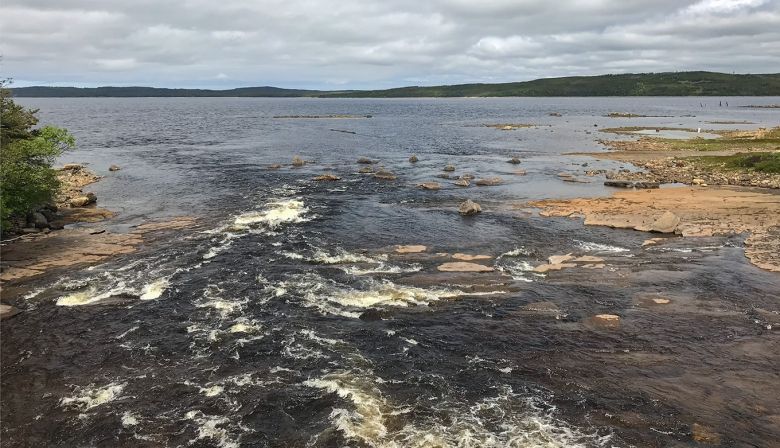

Sackville River
Walter Regan has reported that by 16 June 2021 there have been 4 grilse and 1 multi-sea-winter Atlantic salmon counted.
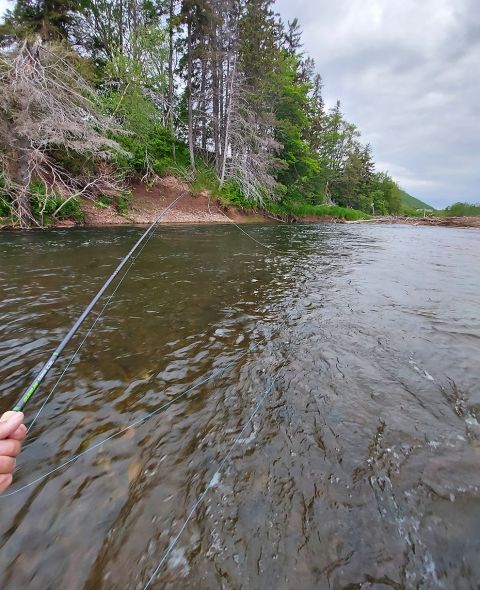
Patrick Poirier notes:
The conditions on the river are fair, with water temperatures good mid 50’s F.
Levels are a little low on the Northeast Margaree for this time of year. The main part of the river below the Forks is good.
On the Southwest Margaree, Lake Ainslie is full and keeping the river level up.
There are a few anglers on the river but not as many as we would normally see this time of year. The salmon run is slowly picking up, but the main summer run has not fully started.
Rain is forecast, and we are hopefully looking forward to a good push of salmon as it passes through.
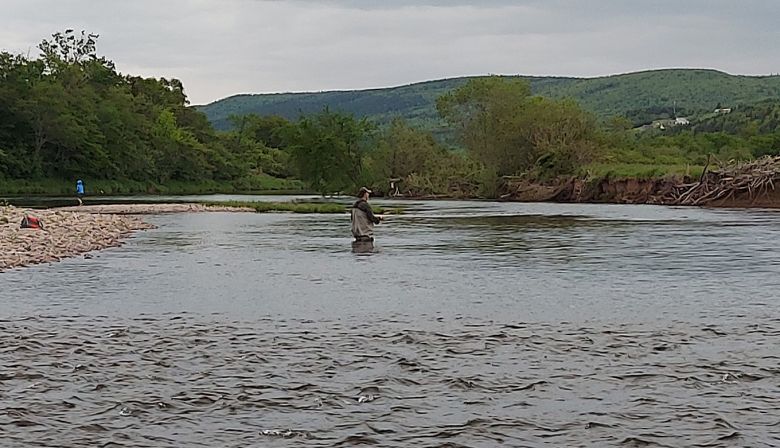
Steve Brooke with the Kennebec Chapter of Trout Unlimited was one of several who monitored Brookfield’s placing of flashboards on the Lockwood Dam at Waterville this week. The boards are installed during times of low flow, to direct more water into the dam’s turbines. As a result, however, water stops filling the pools below the dam.
As the morning continued, it was evident there was a pool in which several adult Atlantic salmon and numerous smolts were trapped. The pool was too deep to net the fish. Two staff from Maine’s Department of Marine Resources told Steve Brooke there were two to four large salmon. As of his note, the salmon were not rescued, although some flow to the pools was later restored.
One 73 cm multi-sea-winter Atlantic salmon was rescued from another location below the dam, and trucked up to the Sandy River to be released. Approximately 30 smolt were also rescued.
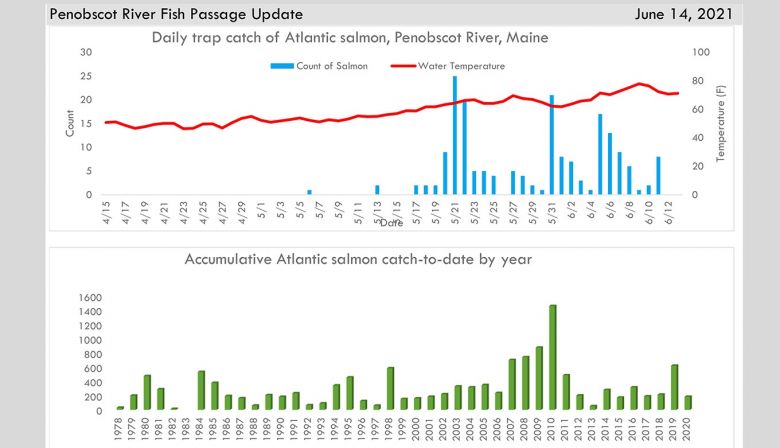
Penobscot
Jason Valliere, Maine DMR Biologist, notes:
River temperatures have risen to the point where we have had to conduct counts via video.
Counts WILL change, both up and down, as data becomes available via video review, PIT data analysis, and as in season recaptures are accounted for.
The numbers counted have been somewhat disappointing, with 185 Atlantic salmon to June 14, less than a third of the returns last year to the same date.
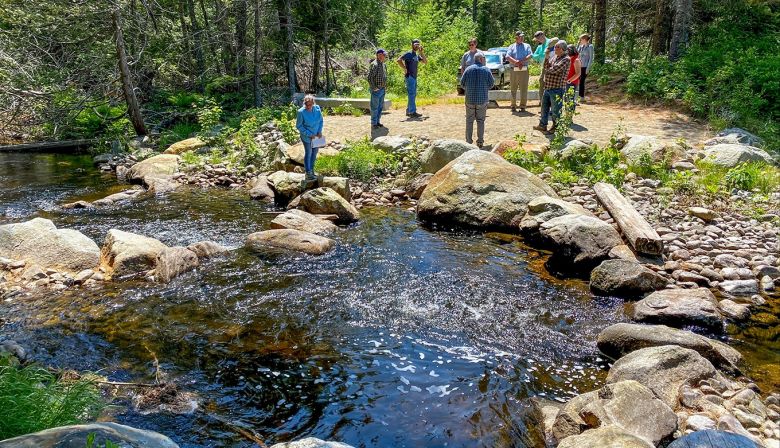
With partners, we are working with a community in the Penobscot considering fish passage options at their lake outlet and to illustrate feasible fishways possible for their site, we took a field trip to various sites to explore nature-like fishways. These fishways retain the pond water levels but still achieve effective downstream and upstream fish passage for river herring and other native species.
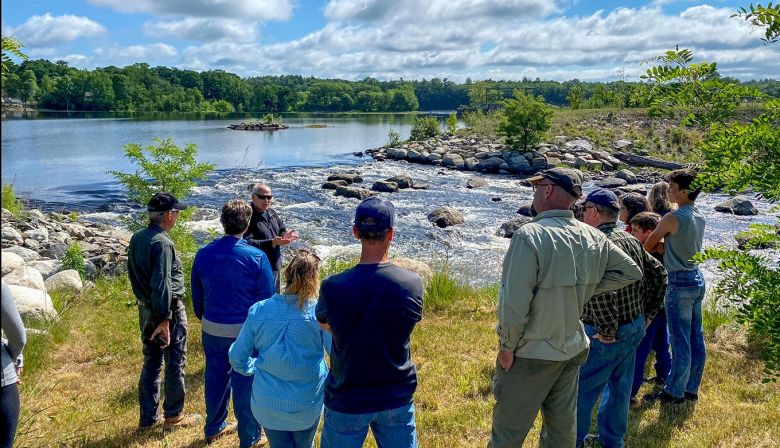
Maranda Nemeth notes:
Low water conditions are still very concerning. A bit of rain swept through but not even 1/4 inch in most places and at most 1/2 inch. The Sandy River is still hitting record lows every day based on 84 years of data.
A similar trend is apparent across most Maine rivers, with streamflow well below normal, and water temperature, perhaps fortunately, below normal.
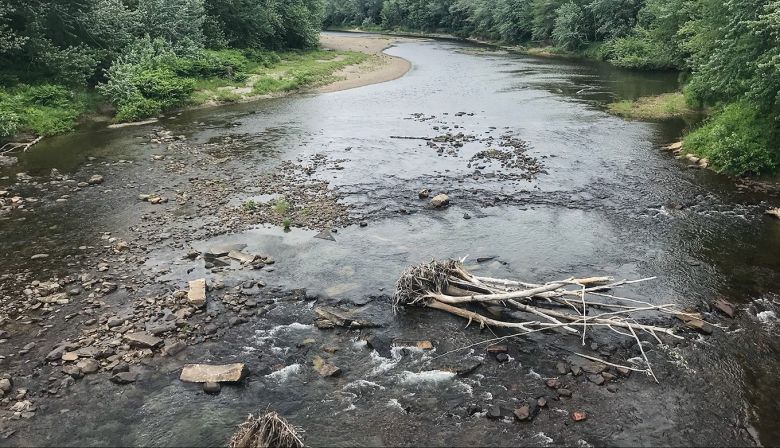
Temple Stream
ASF is collaborating with several partners to monitor the “before and after” conditions of Temple Stream throughout the Walton’s Mill Dam Removal project.
Emily Zimmerman with Maine DEP is working with several students and professors from University of Maine in Farmington here in this photo with the equipment to monitor water quality of the stream. Photo credit to Jen Larson / ASF summer intern.
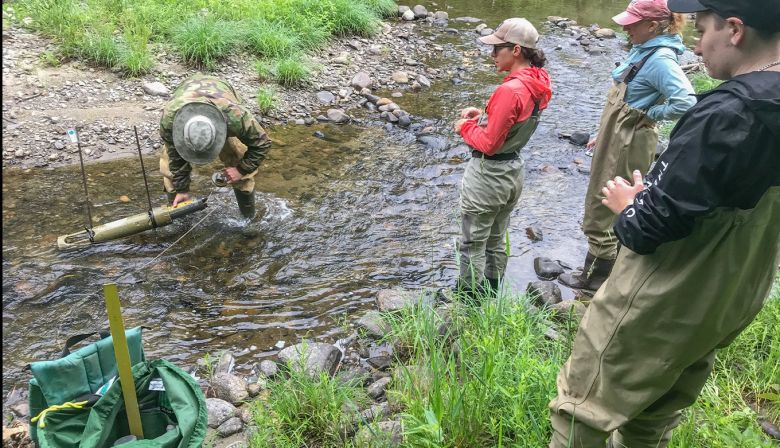
Colby Bruchs, Fisheries Scientist for the Maine DMR, notes there was 1 new large salmon in the past week, making the count 3 so far this year.
He also noted that the river discharge was at or near record low flows.
It would not be a surprise to have an open “Atlantic Bubble” by July 1, but that will still depend on case numbers, the impact of new variants of the virus, and notably on the numbers receiving their second Covid-19 vaccination.
At this moment, New Brunswick is accepting all Canadians without isolation or testing, as long as they have had at least a first Covid-19 vaccination. If they are not vaccinated, isolation and testing is still required. However, Nova Scotia is holding off for a few days on the “Atlantic Bubble”, and where NB has opened its borders to all Canadians, NS remains uneasy on how things will be modified in the weeks ahead.
Meanwhile in PEI, the province is instituting a “pass” which could be said to be a provincial passport. For more details, check out their webpage on applying. Click here
Serious talks are about to begin on the international border between Canada and the U.S., but it would appear that the opening of the border is still months away. This writer’s guess is September, but that is just opinion.
In Atlantic Canada, air flights are about to increase. For example, there will be flights from Saint John to Montreal by the end of June. In addition, PAL is still planning to expand its routes within Atlantic Canada.
In Quebec, there is a complex reopening taking place from now until the end of summer. Check this page for more details. Most encouraging is the Gaspesie Region is “Green,” and while there are still restrictions, they are not especially onerous by the standards of the past 15 months.
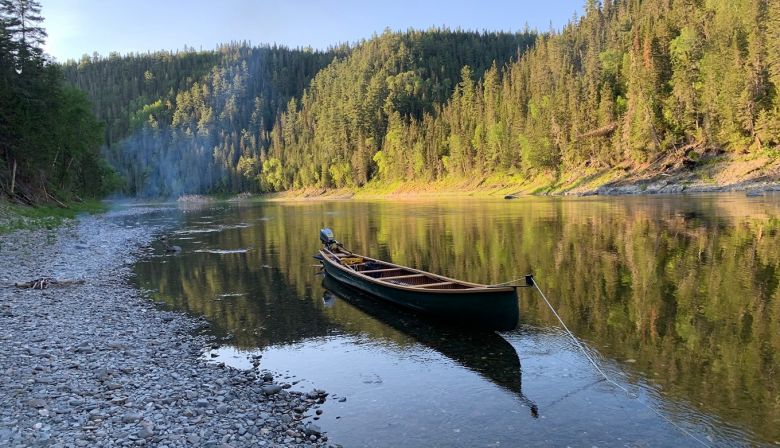
Keep up to date on the world of Atlantic salmon, through this blog and others, and enjoy the feeling of the world opening up again.
